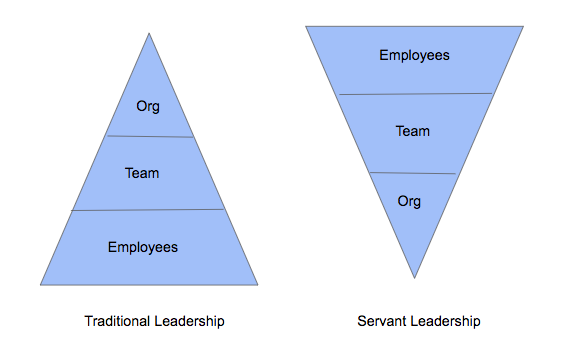Many companies find themselves unexpectedly managing a completely remote workforce due to the global coronavirus pandemic. While some companies have managed the switch seamlessly, many organizations are having to find new ways of working and keeping their newly remote workforce productive in the transition. One area of concern, especially for IT team managers, has been their offshore workforce, which is typically required to be in the office setting.
IT teams will eventually shift their focus from the initial short term challenge of business continuity to leading long-term technology transformation. Wherever you find yourself in this journey, you will need to flex new muscles as your teams become more remote. Let’s take a look at three ways IT leaders can adjust how they manage their teams to maintain productivity and efficiency.
1. Level up on your people-management approach
If there was ever a time for team managers to practice servant leadership, this is it. The characteristics of servant leaders such as having empathy, listening, and supporting the team will go a long way in building trust and loyalty with your employees. Everyone is handling this global crisis differently and acknowledging this is key to establishing trust and safety.
Here are a few things to consider for managers who have moved to a more distributed, remote workforce:
- Psychological safety: As teams become remote, managers should create an environment where employees feel psychologically safe. Establish an open line of communication and trust that they are giving their best.
- Individual and team dynamics: Working and being productive from home doesn’t always come naturally for some. Managers must recognize the learning curve involved in bringing a team up to speed on remote working norms or establish what those norms should be. Team members will go through the transition at their own pace and managers should offer each employee support to help them stay efficient and engaged.
- Efficiency and engagement: One difference between office and remote culture is the perception of efficiency. Provide structured but frequent touchpoints and feedback, daily stand-ups, and office hours — as opposed to ‘checking in’ randomly throughout the day, potentially disrupting employee workflow.
- Professional development: IT teams have to be ‘lifelong learners.’ While they need to continue to learn technical skills, your employees will also need to learn new skills and tools to become better remote workers. Provide the support they need so they are not stagnant in ‘survive mode’ for too long.
- Make it personal: Schedule social meetings (non-work discussion), happy hours, and encourage employees to include family/pets when appropriate. You never know when a social conversation brings up refreshing candor and inspires innovation.

2. Frame IT goals as organizational goals with outcomes for key stakeholders
IT is not only responsible for ‘keeping the lights on’ but can guide the company in setting up frameworks for others to follow. Traditionally IT teams are more flexible when it comes to co-location than other parts of the organization — giving them the opportunity to lead this organizational transition. As the organization adjusts to this new normal, IT can lead the way by focusing on long-term initiatives that will help the business succeed. Here are a few considerations when thinking about your team’s goals:
- Process: How do you ensure teams are goal-driven and communication of those goals is clear? While co-location makes collaboration easier, learning new habits in a remote environment can help make virtual collaboration a foundation of the team. One way to explore this is to move physical kanban to virtual kanban boards, and show other teams how to use them.
- Business collaboration: Ensure that your business counterparts go through this transition with you. Business priorities will likely change; make certain the IT team’s priorities are aligned by conducting virtual ‘workshops’ and check-ins with leadership. As digital transformation accelerates, IT needs to be ready to deliver on a new set of goals.
- Tech transformation: As you and the organization move beyond crisis management, plan to deliver on the digital transformation initiatives from pre-pandemic days. Is it reducing technical debt or moving to cloud? Is it automating manual processes or enhancing the customer experience? However these transformation initiatives are prioritized, stay focused on ROI and speed of delivery.
3. Create an environment that supports experimentation
In a crisis, it’s important to balance short- and long-term thinking and strategic decision-making. This presents a great opportunity to seize the business advantage and start experimenting with ideas that future-proof your organization. These experiments will test your team’s speed and agility, so don’t be afraid to ‘fail fast.’ Challenge your teams to find new ways of working and uncovering new innovations:
- Revisit start-up mentality: As you emerge from the crisis-mode to business-as-usual mode, you will find that your previous business-as-usual operating model doesn’t exist. This is where a start-up mentality can help find a solution to a problem that is yet to be solved. Remove bureaucratic barriers that discourage originality and stifle innovation.
- Create the environment: Real innovation doesn’t occur in a vacuum. Leaders have to create an environment where team members feel challenged and inspired to solve something new. In addition, create a feedback loop to study successes and failures (and reward both).
- Automate process: While the work velocity has slowed temporarily, it will soon return to a level where your team’s speed and agility will be key to delivering business value. Work with your teams to generate ideas on what processes should be automated in the near term. Get their buy-in to prioritize those efforts and monitor the progress.
- Integrating back to work: Challenge yourself and your teams to think about an arrangement that is better suited for tomorrow’s workforce. Experiment with a workweek which is a hybrid of office days, remote days, and weekends. Once the confidence and trust has been established both ways, choose an arrangement that serves your teams, your customers, and your stakeholders better.
- Virtual reality: As social distancing guidelines continue for the foreseeable future, virtual and real worlds will collide. This will require out-of-the-box thinking to conduct your business. While you ‘Zoom’ your team meetings and customer connections, think of larger events, such as conferences, that are critical to your business. How can you partner with your marketing teams to create a community-building event that feels special? One example here at MuleSoft is the totally digital experience for CONNECT 2020 keeping in mind the health and safety of the community.
Managing 100% remote teams is going to be a new experience for many IT leaders. Acknowledge the uniqueness of the situation and give yourself and your team the resources to adjust to the new normal. Enterprises are made of people, whether they are in the office building or at their homes. Be empathetic and supportive of your members, collaborate cross organizationally, and find opportunities to experiment with ideas to prepare for a new tomorrow.
For more information on COVID-19, visit our resource hub.









